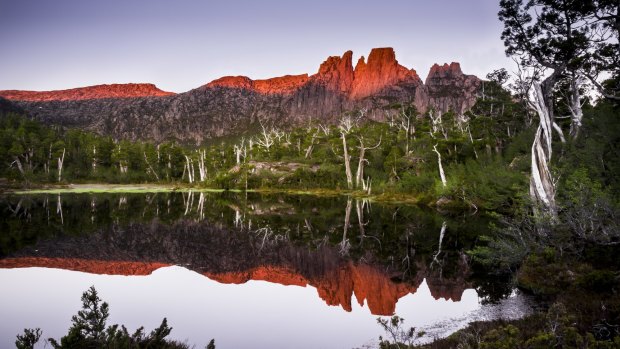This was published 1 year ago
Lake St Clair, Tasmania: The UNESCO-listed wilderness wellness spot is world-class
By Lee Tulloch

Sunset over Mount Acropolis, in the Cradle Mountain-Lake St Clair National Park, Tasmania.Credit: iStock
A few months ago, I visited Lake St Clair, Australia's deepest lake, which is part of the UNESCO World Heritage Cradle Mountain-Lake St Clair National Park in central Tasmania.
The park is internationally known for those adorable social media posts of cute wombats ambling along the boardwalk and for countless Instagram posts of craggy Cradle Mountain reflected in the tranquil waters of Dove Lake.
Lake St Clair, at the southern end, is in fact its own entity. There's the famous Overland Track, a 65-kilometre, multi-day hike through rainforests, moorlands, and alpine heathlands which joins the two landmarks, starting at Cradle Mountain, and which sees 8000 walkers a year from October to May. The walkers stay in timber huts along the way, some dating as far back as 1896.
If "wilderness seeking" is a big motivation for travellers these days, then this pristine landscape, accessible from either Launceston or Hobart, has to be one of the world's best destinations to lose oneself in nature.
I say "lose" because that's what I did, in a way. With no particular agenda or destination, I set out on a walk (well-signposted) through the damp, cool Gondwana forest that surrounds the lake to Watersmeet, a Game of Thrones-sounding meeting of rivers that is one of the shorter walks visitors can do.
It was a very slow form of travel because I was compelled to stop every few metres to admire yet another beautiful pattern on the bark of an ancient tree or another curious-looking moss, to tune myself to the sounds leaves make and the faintest rustlings of creatures in the undergrowth.
I'm more familiar with the city, where a sound — a car exhaust, heavy footsteps — could mean danger, so it took me a while to relax and recognise that the forest noises were benign.
It was only after I'd returned to the warmth of an indoor fire that I realised how much I benefited from that crisp silence. I'd completely left behind the emotional burdens I'd brought with me to the park. I hadn't needed to walk on burning coals or eat a mushroom to have this epiphany. I just needed to empty my mind enough to reset it.
"The only sounds you hear here are the screams of people swimming, when they realise how cold the water is," says Peter Feil, who oversees the team of Tasmanian Parks and Wildlife Service rangers at Lake St Clair, which includes several Indigenous trainees. They're tasked many responsibilities, including track repairs, clearing felled logs, maintaining the huts and campgrounds, animal rescue, fire fighting, manning the visitor centre and even cleaning the toilets in the park – the heroic to the menial. Because it's a UNESCO site there's a large amount of paperwork relating to compliance with UNESCO's strict rules.
I don't think it surprises anyone to know that the most pressing danger to this exquisite landscape is the human animal, and not only in the broader context of how we're impacting climate change. Ranger Frank Garbe tells me the changing climate has brought less snow, below- average rainfall and more lightning strikes, which set off bushfires. The lack of rainfall also means fires can smoulder in the peat for months and reignite weeks afterwards. In his opinion the magnificent huon pine probably won't ultimately survive.
But the most immediate problems come from thoughtless and stupid people. According to Garbe, much of the rangers' work involves stopping people chain-sawing trees for firewood, lighting campfires on total fire ban days or bringing dogs illegally into the forest. The rangers break up large parties, rescue drunks or hikers who are not properly prepared for the wilderness, search for missing people, administer first aid after accidents and organise medical evacuations.
People still use the park as a dumping ground for rubbish. Sickeningly, some people also hunt wildlife. It's hard to fathom the mindset, but the UNESCO listing in 1982 and the parks and wildlife services have given this precious wilderness a fighting chance.
There's a $200 fee for a pass to walk the Overland Track and it has a wait list, but entry to the park itself via the Tasmanian National Parks Pass is available for a modest fee. Australia's 870 national parks and reserves represent some of the best value travel anywhere.
Cradle Mountain-Lake St Clair tops the international "hot list" for wilderness wellness and we have access to it for a pittance.
Sign up for the Traveller Deals newsletter
Get exclusive travel deals delivered straight to your inbox. Sign up now.